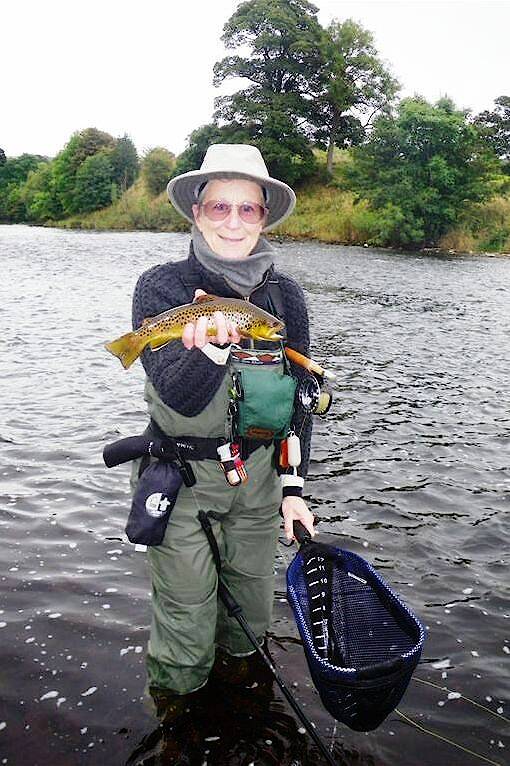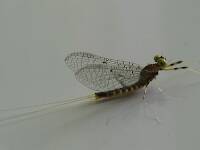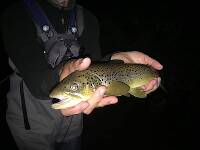
Salmonflies
Pteronarcys californica
The giant Salmonflies of the Western mountains are legendary for their proclivity to elicit consistent dry-fly action and ferocious strikes.
Featured on the forum

Troutnut is a project started in 2003 by salmonid ecologist Jason "Troutnut" Neuswanger to help anglers and
fly tyers unabashedly embrace the entomological side of the sport. Learn more about Troutnut or
support the project for an enhanced experience here.
Sb_farming
Posts: 1
Posts: 1
Sb_farming on Jun 10, 2007June 10th, 2007, 4:21 am EDT
Here's my 2 cents on this that I already posted on another forum:
FlyAddict topic link
Although the typical antron wing spinner is pretty easy to see. Another trick is to use a wet fly. I use phesant tail body (reverse ribbed with fine gold wire) and partridge wet fly style collar. This one seems to knock 'em dead!
FlyAddict topic link
Although the typical antron wing spinner is pretty easy to see. Another trick is to use a wet fly. I use phesant tail body (reverse ribbed with fine gold wire) and partridge wet fly style collar. This one seems to knock 'em dead!
Wiflyfisher on Jun 10, 2007June 10th, 2007, 1:39 pm EDT
Actually I think the night vision binoculars are the way to go. I think while wearing those binoculars everyone else with leave the pool and I will have it all to myself. :)
John S.
https://WiFlyFisher.com
https://WiFlyFisher.com
Shawnny3 on Jun 10, 2007June 10th, 2007, 1:49 pm EDT
...a good idea until a passing car's headlights blind you for life. I wonder how many wading accidents have occurred that way...
-Shawn
-Shawn
Jewelry-Quality Artistic Salmon Flies, by Shawn Davis
www.davisflydesigns.com
www.davisflydesigns.com
Troutnut on Jun 10, 2007June 10th, 2007, 5:23 pm EDT
Actually I think the night vision binoculars are the way to go. I think while wearing those binoculars everyone else with leave the pool and I will have it all to myself. :)
Great idea, and just in time for the Hex fiasco!
Maybe some Pennsylvania members can try it out for next year's green drake hatch on Penn's Creek. Mix it with some spooky music, or a faked alien spacecraft, and you could probably clear out at least half the guys in your pool.
Jason Neuswanger, Ph.D.
Troutnut and salmonid ecologist
Troutnut and salmonid ecologist
GONZO on Jun 10, 2007June 10th, 2007, 5:49 pm EDT
Jason, you may be underestimating the tenacity of Penn's Creek green drake addicts. After all, they complain endlessly about how hard it is to catch fish during that hatch, yet they return year after year. Unless that alien spacecraft had a transporter beam to wisk them away, I'm convinced that many would line up at a night vision goggle stand and happily fork over five or six hundred dollars a pair just to have a few more shots at the fish they're not catching. ;)
Invicta on Jun 11, 2007June 11th, 2007, 12:45 pm EDT
Taking a serious look at the problem you face there maybe another type, or two, of light solutions that would work. Having experience with LW and SW portable battery powered ultraviolet lamps for mineral exploration I know that they are capable of projecting a UV beam several dozens of feet depending on the target material. Pick up one at a geological supply house, set it high enough on shore to cover the area you are fishing, place a target material of your choice on the spinner and enjoy. Those lamps are also great for finding scorpions, sun spiders, centipedes, some ants, and assorted other nighttime beasties; not the mention the odd unique mineral or two. The other choice might be a LED flashlight in blue beam. It appears that several red dyed synthetics are highly reflective, red, in blue LED frequencies. I don’t know if all blue LED behave the same way with synthetics, but the one I have made an impressive showing on my stash of yarn when I tried it last. You’ll have to leave the light on, but the lumens shouldn’t be so great as to put down the fish…come to think of it, you might be able to get the fish to respond to the light as a feeding stimulus if it is used often enough.
John
John
Martinlf on Jun 11, 2007June 11th, 2007, 6:23 pm EDT
Invicta, with this clever idea you've convinced me that I need to reassess the residents of California. Totally cool. But I'm still looking for those beers. If they're virtial, does Wifly have the password?
"He spread them a yard and a half. 'And every one that got away is this big.'"
--Fred Chappell
--Fred Chappell
Invicta on Jun 11, 2007June 11th, 2007, 6:59 pm EDT
Perhaps the password isn't important...to rephrase Wifly 'Keep the memories, pass the beer'.
John
John
Martinlf on Jun 12, 2007June 12th, 2007, 12:45 am EDT
Invicta,
Will do. And all in good fun. If you're ever this way, we'll show you some good spinner fishing. :)
Will do. And all in good fun. If you're ever this way, we'll show you some good spinner fishing. :)
"He spread them a yard and a half. 'And every one that got away is this big.'"
--Fred Chappell
--Fred Chappell
Invicta on Jun 12, 2007June 12th, 2007, 2:16 am EDT
Louis,
Thanks very much, I would really like to do that. But, it may have to wait a bit, you're a long ways from downtown CA.
John
Thanks very much, I would really like to do that. But, it may have to wait a bit, you're a long ways from downtown CA.
John
Nightfisher
Posts: 7
Posts: 7
Nightfisher on Jun 14, 2007June 14th, 2007, 7:39 am EDT
We do a lot of fishing at night and have tried everything. Forget about what color the fly is supposed to be and concentrate on its Silhouette. Make it as white as you can. Fish by sound not sight. Stalk up as close as you can to a feeding fish. I catch a lot of nice fish with not more than 5 ' of fly line past the tip of the rod. Watch the fly, or where you think it is, with your peripheral vision not directly looking at the fly. Strike at sounds near where you think your fly is. Be ready to miss a lot. But when you connect .....
Troutnut on Jun 14, 2007June 14th, 2007, 8:09 am EDT
with your peripheral vision not directly looking at the fly
That's a great tip. I used to do that all the time when I did lots of backyard astronomy, because peripheral vision is significantly better at picking up on really faint objects. Odd I never thought to carry that over to night fishing before.
Jason Neuswanger, Ph.D.
Troutnut and salmonid ecologist
Troutnut and salmonid ecologist
Invicta on Jun 14, 2007June 14th, 2007, 9:27 am EDT
During all this discussion I hadn’t thought about how little experience most of us have negotiating around outside in the dark, so a couple of tips may help with spinners and other things. This may be off-topic, but if it saves one of us from having a broken ankle it isn’t wasted. As Nightfisher pointed out, we need to use our peripheral vision after dark.
Though the eye receives data from a field of about 200 degrees, the acuity over most of that range is poor. To form high resolution images, the light must fall on the fovea, an area of the retina having a high concentration of cone cells, and that limits the acute vision angle to about 15 degrees. In low light, this fovea constitutes a second blind spot (the first being where the optic nerve enters the retina) since it is exclusively cones which have low light sensitivity. At night, to get most acute vision one must shift the vision slightly to one side, say 4 to 12 degrees so that the light falls on some rods.
Since the fovea provides the sharpest and most detailed information, the eyeball is continuously moving, so that light from the object of primary interest falls on this region, cone cells in the fovea are individually connected to nerve fibers.. ...the rods (B&W vision), on the other hand, are connected in groups to nerve fibers, and a single such fiber can be activated by any one of about a hundred rods. The actual perception of a scene is constructed by the eye-brain system in a continuous analysis of the time-varying retinal image; apparently, also not unlike the night vision of a trout. The exception is that trout has rod cells in the central portion of its visual field. While we cannot look directly at an object at night and expect to obtain any visual acuity, a trout apparently can.
To obtain and keep your night vision will take about twenty minutes with no exposure to any obvious light source. Any exposure to a bright light will destroy the sensitivity of the rod cells, and you will have to start over. A soft red light source can be used to assist in seeing surroundings most easily, but this light can be seen by others (fish?) just as well. Some caution should be exercised to shield the light source from direct exposure to the water. However, even after having extensive training in the subject, I must point out that I have lost the desire to stumble around in the dark with my companions after having discovered the social advantages to barbequed meat and strong drink.
John
Though the eye receives data from a field of about 200 degrees, the acuity over most of that range is poor. To form high resolution images, the light must fall on the fovea, an area of the retina having a high concentration of cone cells, and that limits the acute vision angle to about 15 degrees. In low light, this fovea constitutes a second blind spot (the first being where the optic nerve enters the retina) since it is exclusively cones which have low light sensitivity. At night, to get most acute vision one must shift the vision slightly to one side, say 4 to 12 degrees so that the light falls on some rods.
Since the fovea provides the sharpest and most detailed information, the eyeball is continuously moving, so that light from the object of primary interest falls on this region, cone cells in the fovea are individually connected to nerve fibers.. ...the rods (B&W vision), on the other hand, are connected in groups to nerve fibers, and a single such fiber can be activated by any one of about a hundred rods. The actual perception of a scene is constructed by the eye-brain system in a continuous analysis of the time-varying retinal image; apparently, also not unlike the night vision of a trout. The exception is that trout has rod cells in the central portion of its visual field. While we cannot look directly at an object at night and expect to obtain any visual acuity, a trout apparently can.
To obtain and keep your night vision will take about twenty minutes with no exposure to any obvious light source. Any exposure to a bright light will destroy the sensitivity of the rod cells, and you will have to start over. A soft red light source can be used to assist in seeing surroundings most easily, but this light can be seen by others (fish?) just as well. Some caution should be exercised to shield the light source from direct exposure to the water. However, even after having extensive training in the subject, I must point out that I have lost the desire to stumble around in the dark with my companions after having discovered the social advantages to barbequed meat and strong drink.
John
Konchu on Jun 14, 2007June 14th, 2007, 3:45 pm EDT
Any advise for seeing down to the stream bottom at dusk? Any light that works better than others? I've gotten caught out in the middle a few times and luckily didn't snap my neck on the way back in. Angled light makes it really hard to see where you're stepping.
Troutnut on Jun 14, 2007June 14th, 2007, 4:53 pm EDT
Any advise for seeing down to the stream bottom at dusk? Any light that works better than others? I've gotten caught out in the middle a few times and luckily didn't snap my neck on the way back in. Angled light makes it really hard to see where you're stepping.
Have you tried a wading staff?
I just started carrying one this year. I'm generally very good at keeping my balance so I never bothered before, but I'm glad I got it. At first I made the common mistake of using it to try wading where I otherwise would not, and almost got washed down the East Branch of the Delaware. Soon I stopped carrying it out all the time, and instead just keep it broken down in its holster on my wading belt. I break it out if I have to cross somewhere a little sketchy or, more often, I'm wading in the dark and can't see what's in front of me, so it's handy for feeling around.
Of course, you could just use a stick for that, too. But if there's one thing fly fishermen have in common, it's the unwillingness to use a plain old stick when a fancy one is available.
Jason Neuswanger, Ph.D.
Troutnut and salmonid ecologist
Troutnut and salmonid ecologist
Shawnny3 on Jun 14, 2007June 14th, 2007, 5:18 pm EDT
Holy crap, John - you sound like you could write an ophthalmology textbook. Seriously, that was an excellent explanation. I understood it better than when my eye doctor was explaining some of those things to me awhile back. Very helpful things for a fisherman to know. Thank you.
-Shawn
-Shawn
Jewelry-Quality Artistic Salmon Flies, by Shawn Davis
www.davisflydesigns.com
www.davisflydesigns.com
Invicta on Jun 14, 2007June 14th, 2007, 9:31 pm EDT
Shawn, glad I could help. Konchu, about seeing into the stream at dusk…the idea Jason had about using a wading staff isn’t a bad idea. But, if you are like me, there are occasions when you really want to see where you are going to step; and placing a light beam from your head, or hand, on the water surface largely just reflects the beam off at an angle away from you. To solve the problem I have taped a small AA waterproof flashlight to the lower portion of my wading staff, so that its beam shines under the water not above it. The light works pretty well, if you take your time and don’t bash the light on too many rocks.
Where I fish, wading staffs are common equipment. From experience I need to offer one note of caution on the use of foldable, belt-carrying wading staffs. While really convenient to carry, the same ease of folding may present itself at a really awkward moment if the tip gets wedged between two rocks. Should you need to move the staff quickly to aid your next step the tip stays put, the cord stretches, and you now have a staff much shorter than you were expecting with which to support your weight. It’s a good way to take a serious fall. If you need support use a solid staff, it may save your life.
John
Where I fish, wading staffs are common equipment. From experience I need to offer one note of caution on the use of foldable, belt-carrying wading staffs. While really convenient to carry, the same ease of folding may present itself at a really awkward moment if the tip gets wedged between two rocks. Should you need to move the staff quickly to aid your next step the tip stays put, the cord stretches, and you now have a staff much shorter than you were expecting with which to support your weight. It’s a good way to take a serious fall. If you need support use a solid staff, it may save your life.
John
Nightfisher
Posts: 7
Posts: 7
Nightfisher on Jun 15, 2007June 15th, 2007, 1:22 am EDT
I shuffle my feat and try to check the spot out first in the light. It is almost imposible to know where to cast unless you see it in the light first. That sweeper you think is 30 ft away may only be 10. I try to avoid using a light at all costs. Even when i need to change flies i wade up on shore to do it. Light can kill a spot. Some guys say that a red filter on the light doesnt spook the fish.
Wiflyfisher on Jun 15, 2007June 15th, 2007, 1:37 am EDT
But, if you are like me, there are occasions when you really want to see where you are going to step;
The Big Hole River in Montana is definitely one of those rivers where you better see the bottom before you take a step! It can be shallow one step and the next can be in a big hole. Wading in the dark is almost suicide.
Aluminum cleats help on some Western rivers too.
John S.
https://WiFlyFisher.com
https://WiFlyFisher.com
CaseyP on Jun 15, 2007June 15th, 2007, 4:09 am EDT
Of course, you could just use a stick for that, too. But if there's one thing fly fishermen have in common, it's the unwillingness to use a plain old stick when a fancy one is available
used to think that too, but kept winding up out in the river with all the sticks on the bank. a broomstick with a light, long bungee is a cheap and very adequate substitute that floats by your side out of the way, doesn't cost much when it breaks, and doesn't tempt you to go places you shouldn't. (learned the hard way that it's a balance aid, not a third leg.) however, had to buy a fancy one to travel...
my family won't appreciate all the vision info you're giving me--now i'll never get off the water!
"You can observe a lot by watching." Yogi Berra
Quick Reply
Related Discussions
Topic
Replies
Last Reply
4
May 15, 2008
by Vermonter
by Vermonter









